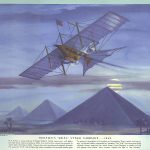
15 Early *Failed* Attempts at Flight – Before the Wright Brothers…
February 20, 2024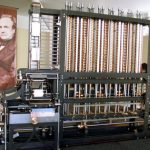
Origins of the Digital Age (Part 1: Mechanical Clocks, Electricity, and Radio) – A Timeline
March 5, 2024“Flying is learning how to throw yourself at the ground and miss.” – Douglas Adams (Hitchhiker’s Guide to the Galaxy)
Ever since the Wright Brothers’ first successful flight in 1903 (for more on that, check out my previous article: ‘Pioneers of the Sky: 25 Epic Aviation Milestones!’), there have been a lot of truly awful aircraft designs, from poorly designed prototypes to the absolutely absurd, and a few that are just straight-up ugly. Here are some of the *Worst* Aircraft ever conceived and constructed…
1. “The Christmas Bullet” (1918-1919)
There were A TON of terrible “aeroplane” designs prior to 1903 (click here for more on those), but those were *before* we truly understood the basics of aeronautics, or for that matter, if heavier-than-air craft were even possible! However, 15 years *after* the Wright Flyer, one man decided to ignore the experts and start from scratch, creating what many people consider to be the single worst aircraft EVER made…
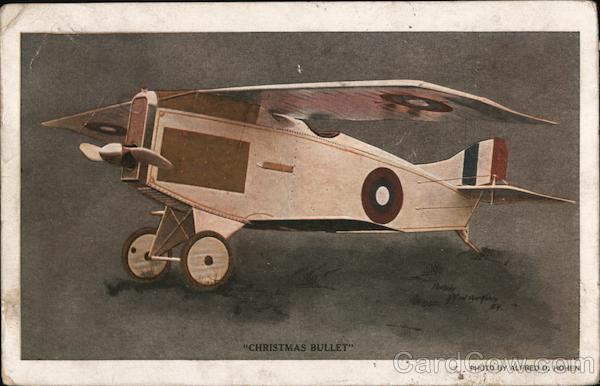
Despite it’s festive name, “The Christmas Bullet” was a death trap.
Just as World War I was coming to a close, Dr. William Whitney Christmas – a physician with literally no background in aviation or aircraft design, decided to design and build his own airplane. He started up his own company in Washington, DC, later moving up north to New York, and began work on conning a couple of wealthy businessmen into backing him. He bold-face lied about his credentials, claimed that he invented the ‘aileron’ (he didn’t), and even said that his company was swamped with orders from Europe (it wasn’t). At one point he stated that he turned down *millions* of dollars to “take over” Germany’s Airforce, and he once tried to convince his backers that his aircraft was part of an elaborate plot to kidnap Kaiser Wilhelm II of Germany.
Despite ALL the red flags, in 1918, Dr. Christmas somehow managed to convince the US Army to lend him a prototype Liberty-6 engine! The army let him borrow the engine for “ground testing only”, but he ignored that part and immediately strapped it to his brand new prototype: The Cantilever Aero Bullet – an all-wood “Strutless Biplane” with flimsy, paper-thin, steel cantilever wings. None of the materials used to create this flying death trap were considered “aircraft grade”, even at that time. When someone pointed out to him that without struts, the wings would just flap in the wind, he said that the wings were meant to be flexible and flap… like a bird.
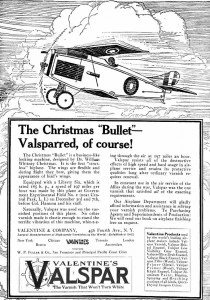
In January, 1919, Christmas persuaded Cuthbert Mills, an out of work pilot, to take the “Bullet” on it’s maiden flight. That fateful day, shortly after takeoff, the flimsy wings of the doomed contraption peeled away from the fuselage, causing the plane to crash, instantly killing its pilot. What’s even worse: Mills had invited his mother to the event! Instead of apologizing, or admitting to himself that he may have cut some corners, William Whitney Christmas doubled down on his “revolutionary” wing design.
To try and save face, Christmas immediately got to work on a second prototype, this time with a Hall-Scott L-6 engine, and even had the gall to put out a magazine ad stating that the Bullet had performed a top speed of 197 mph (ignoring the fact that it also had crashed during that same flight). His second plane was then put on display at a New York Air Show, billed as the “Safest, easiest controlled plane in the world!” despite not yet having a single successful test flight.
Later that year, the second ‘Christmas Bullet’ was flown for the first (and last) time by Lt. Allington Joyce Jolly. Just like with the first one, the plane took off, the wings twisted and folded like tinfoil, causing the plane to plummet to the ground, once again killing its test pilot on impact…
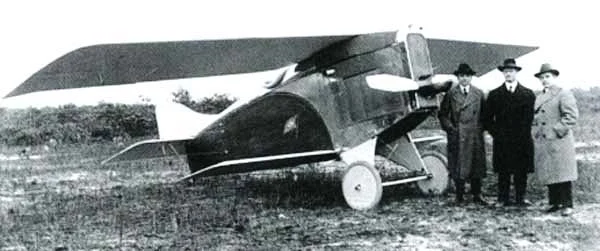
Not only was this con man never prosecuted, he continued to campaign for further funding of his numerous rejected patents. To add further insult to injury, despite losing a prototype engine that they specifically told him not to fly, Dr. Christmas decided to bill the Army $100,000 for the loss of his airplane. The craziest part? They actually paid the bill!
2. “The Flying Boat”: Caproni Ca. 60 (1921)
Less than 20 years after the Wright Brothers’ first airplane, Italian aviation enthusiast and wealthy industrialist, Gianni Caproni decided to make a “Flying Boat”… just because.
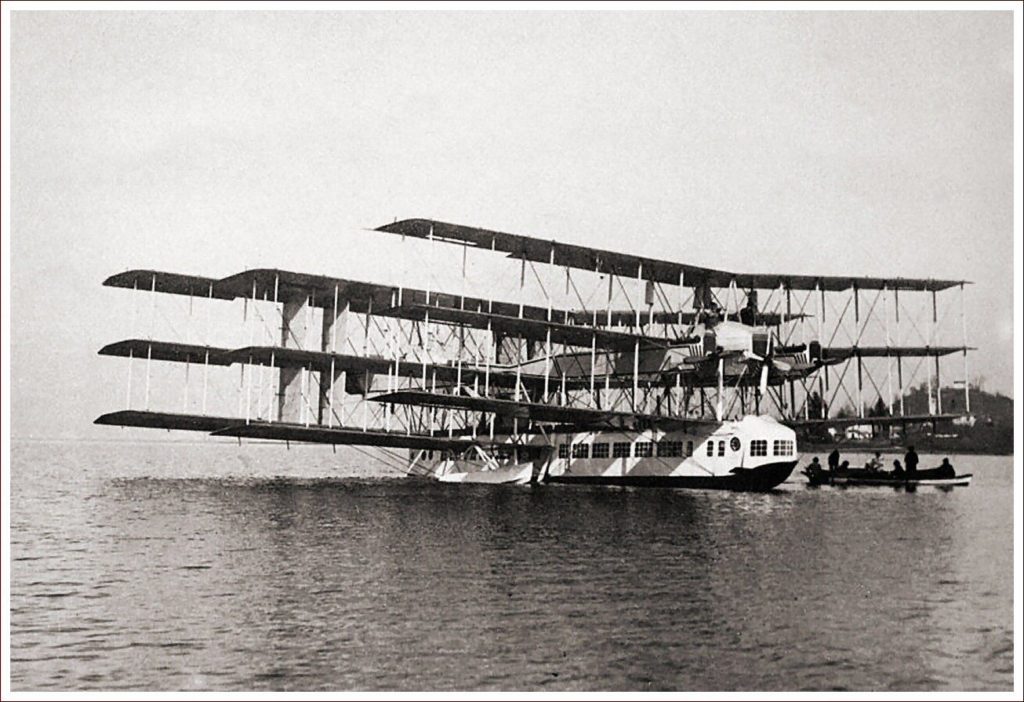
In 1921, the monstrous Caproni Ca. 60 made it’s debut: a 9-winged, 74-foot long, 31-foot tall prototype with a 100-foot-long wingspan, weighing well over 30,000 pounds, with 4 propellers powered by 8 piston engines, each with 400-horse-power! It was meant to be a luxury vessel capable of carrying 100 passengers. Unfortunately, the thing was barely sea worthy, much less aerodynamic. After a very brief maiden voyage / flight on a lake in Switzerland, the ‘Flying Boat’ fell apart on it’s second test flight, shortly after taking off, crashing into the water, and damaging the failed experiment beyond repair.
Points for trying, I guess?
3. French Blériot 125 (1930-1933)
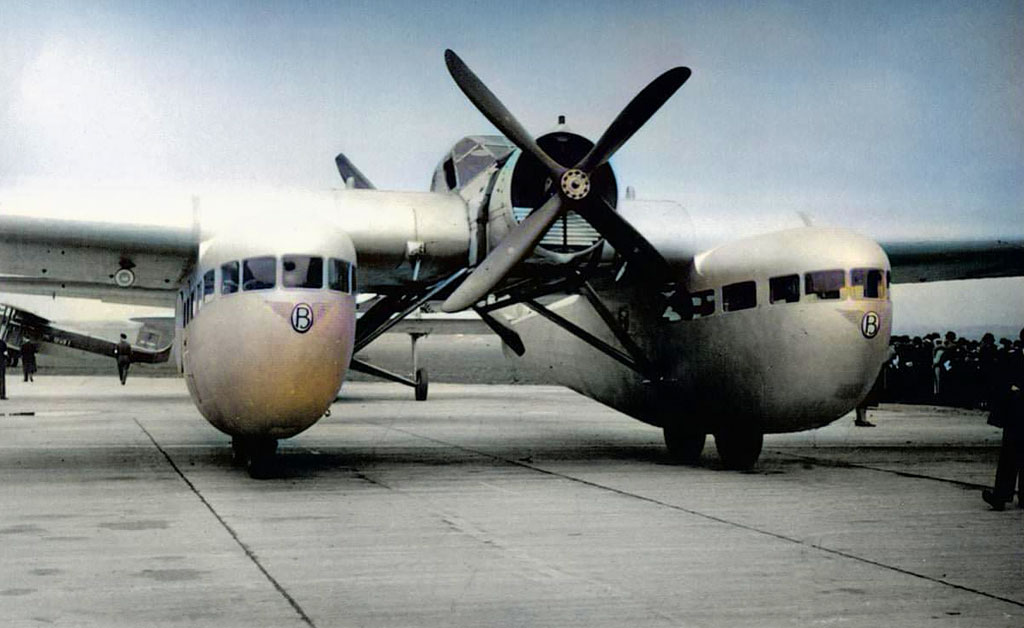
Another unusual, and highly impractical design, The Blériot 125 was a French airliner proposed in the early 1930’s. The defining feature of this bizarre aircraft was the twin fuselage pods that seated up to 12 passengers on either side of a single nacelle with two engines, and was designed for two pilots. It “displayed very poor flight characteristics”, failed it’s certification, despite numerous attempts, and was ultimately scrapped in 1933… because of course it was.
4. Soviet Kalinin K-7 (1931-1935)
Like something straight out of a comic book, this Russian leviathan was an experimental Soviet “Flying Fortress” – the Kalinin K-7! The K-7 was one of the largest aircraft ever constructed (prior to the jet-age), with a length of 91 feet, 40 feet tall, and a wingspan of 173 feet! Constructed primarily of steel, with six gigantic propellers – it weighed nearly 42 tons, and could carry 9.6 tons of ammunitions and / or as many as 120 civilians, with a crew of 11! Outfitted with 8 cannons and 8 machine gun turrets, this metallic beast somehow managed a max speed of 140 miles-per-hour!
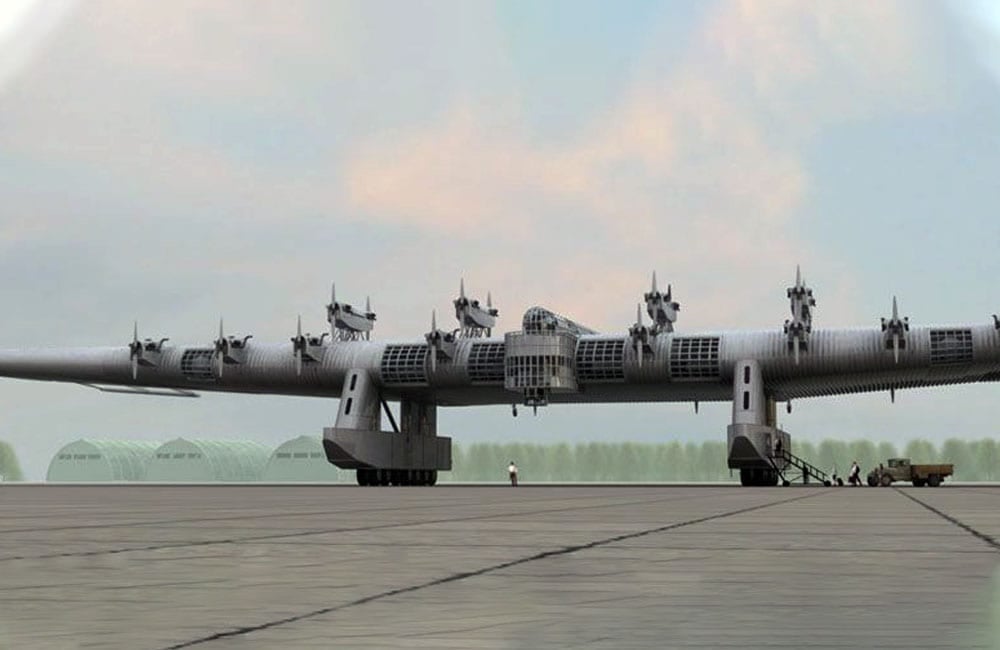
I wonder what kinda gas mileage it gets?
After 2 years of construction, the first of three prototype bombers was ready to deploy. It’s first (brief) test flight occurred on August, 11th, 1933, which immediately showed airframe instability due to vibrations from the engines. Shortly after it was announced to the public as a “victory of the utmost political importance”, the K-7 crashed on it’s seventh and final test flight that November. The accident killed 14 people aboard and one poor shmuck on the ground. Sabotage was suspected at the time, but it was most likely due to structural failure from one of it’s twin tail booms. The project was ultimately cancelled altogether in 1935, for the best.
5. Stipa-Caproni “The Flying Barrel” (1932)
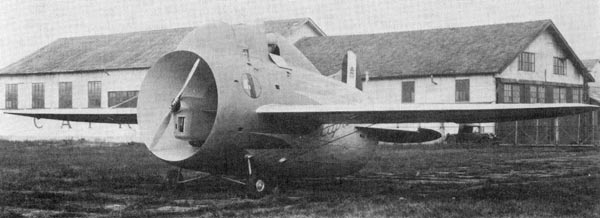
The Stipa-Caproni was an experimental Italian prototype, often referred to as ‘The Flying Barrel’, because of its fat and stubby look. Designed by Luigi Stipa, and developed by the Caproni company in 1932, this uh… unique compact plane was turned down by the Italian Royal Air Force as it was rather impractical for either combat or cargo. That said, it may have inadvertently inspired the invention of the jet engine years later!

6. The Nemeth Parasol (1934)
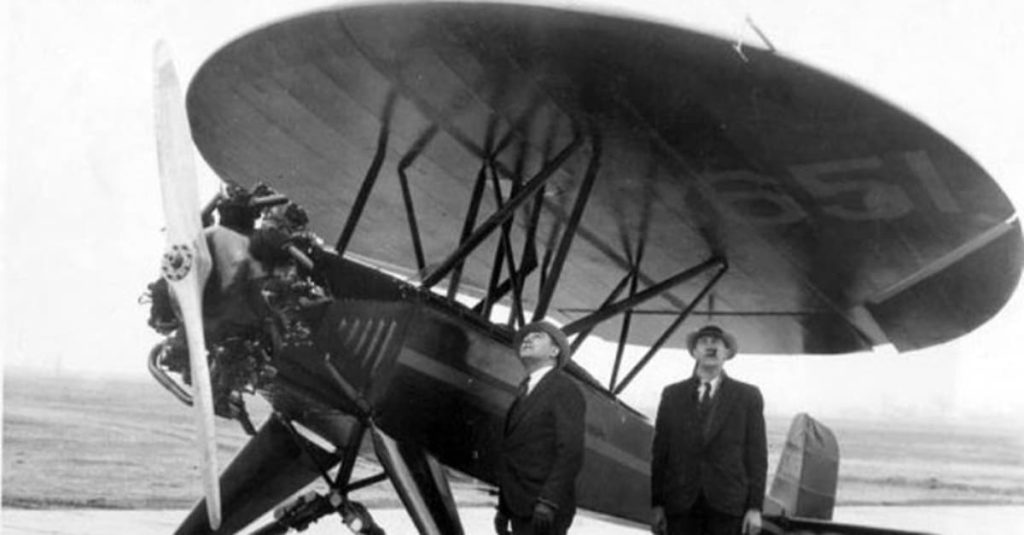
Another perplexing aircraft design, The Nemeth Parasol! Designed by Steven Nemeth of Dayton, Ohio (the Wright Bros hometown) in 1934, the Parasol was a small, “round-wing” aircraft – the first of its kind! Nemeth’s concept was to create a plane compact enough to fit in a garage instead of a hangar. While the design never caught on (for some reason), this one-of-a-kind aircraft had a couple of interesting features: it could take off in just 63 feet because of its large “wing”, and its round-wing design gave it the ability to ‘parachute-stall’ when landing, and only needed 25 feet to come to a stop!
7. German Blohm & Voss BV 141 (1938-1940) – WWII
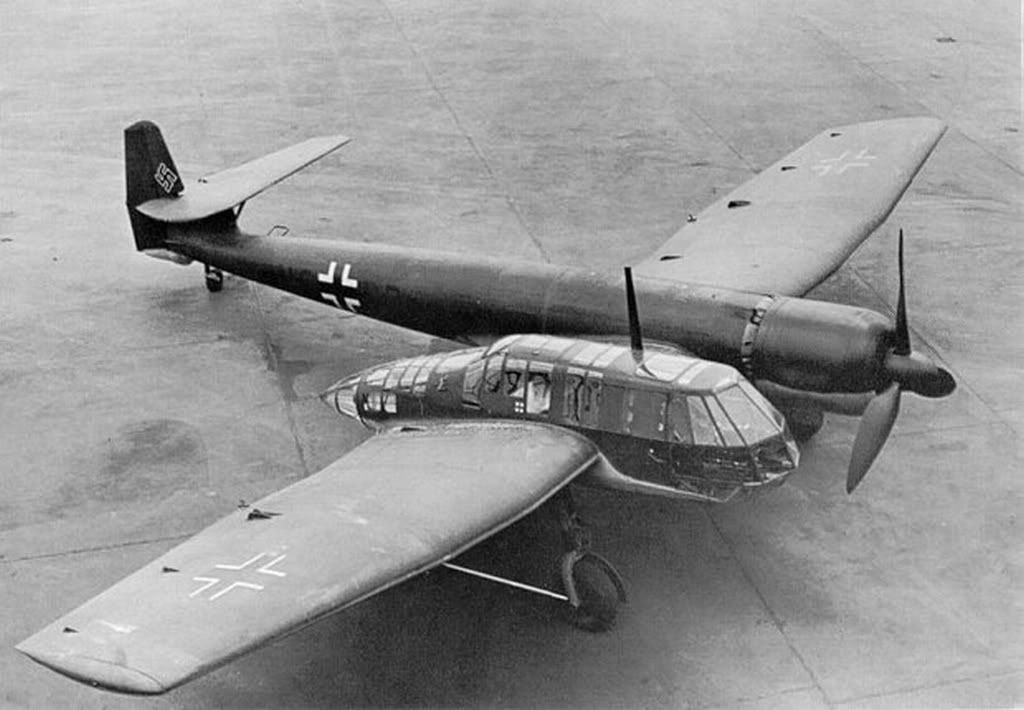
Another truly baffling aircraft design, the Blohm & Voss BV141 was an *asymmetrical* reconnaissance aircraft created by the Nazis during WWII. It was designed to give the plane’s crew greater visibility in both the front and back (as well as full ranged firing ability for a rear gunner), but compromised on balance and maneuverability. Designed by Dr. Richard Vogt, this Frankenstein-ed craft never made it into full-scale production for several reasons.
The British journal, ‘Aeroplane’ wrote: “Richard Vogt, that original man, turns out aeroplanes uglier than most any other designer can.” Several wrecked BV 141s were found by advancing Allied forces towards the end of the war. After Germany was defeated, Dr. Vogt was one of several Nazi scientists brought into the fold by the American military (in secret) as part of “Operation Paperclip”, and later helped to develop the Boeing 747 Jumbo-Jet.
8. “The Flying Pancake” Vought V-173 (1942-1947)
Perhaps one of the strangest planes ever built, the Vought V-173 quickly earned the nickname “The Flying Pancake”!
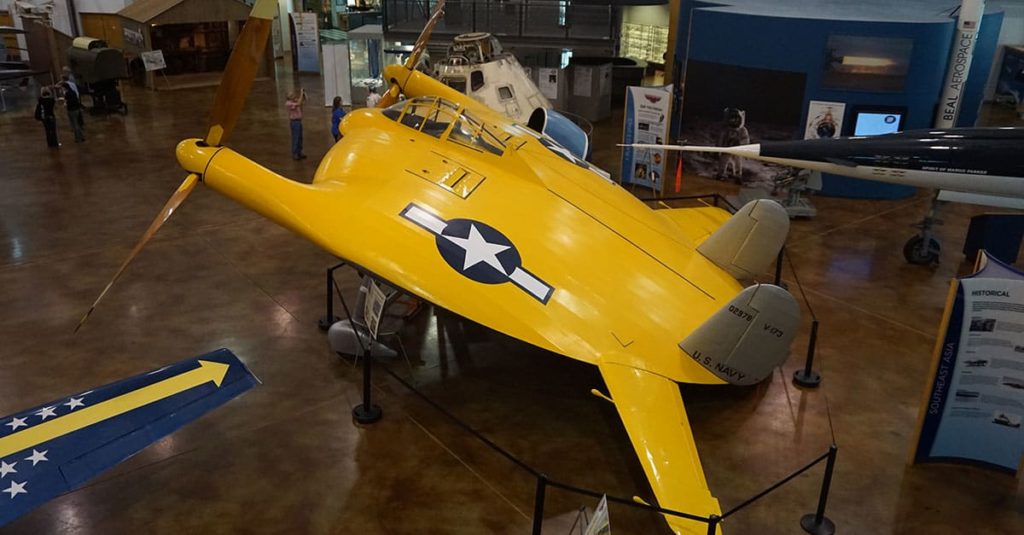
Designed as an “all-wing” aircraft by Charles H. Zimmerman, this bright yellow experimental craft was developed during WWII, and continued to be flight tested until 1947, when the US Navy realized that it served little to no practical use. During test flights, the pilots complained about the poorly designed cockpit and how uncomfortable it was to fly. The Flying Pancake also had trouble achieving enough speed to level out, because of it’s awkward design. And to top it off, the plane acted as an airbrake when it was at a high angle of attack, making it extremely hard to operate at low speeds, particularly during takeoff and landing – which you know, might be important or something…
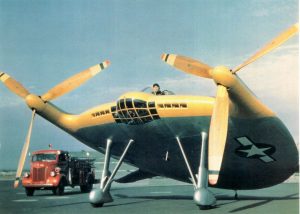
9. “The Goblin” McDonnell XF-85 (1948-1949)
Another confounding aircraft first conceived of during WWII is the McDonnel XF-85 aka “The Goblin”!
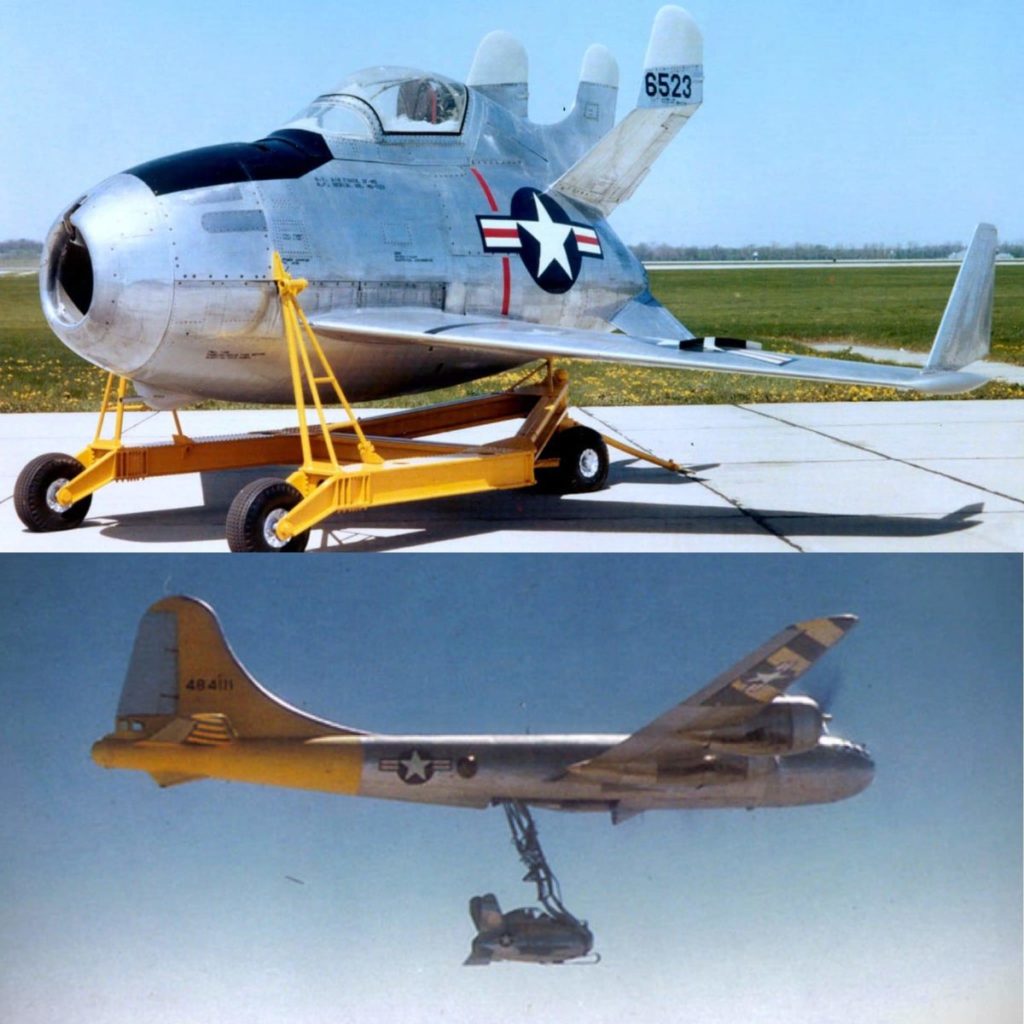
This tiny (borderline-cute?) American jet fighter was another failed experiment that went nowhere. The Goblin sported a distinctive “potato-shaped” fuselage with a fork-tailed stabilizer. It was designed as a “parasite fighter” that would be dropped from the bomb bay of a Convair B-36 bomber to protect the “mother ship” from incoming fighter planes, before returning back to re-dock with the bomber in mid-air. In fact, it didn’t even have its own landing gear! Referred to as a “guided cruise missile”, the McDonnell XF-85 was flight tested three times in 1948, with two prototypes, it was only able to re-dock with the bomber once thanks to it’s completely terrible maneuverability. It was swiftly cancelled the following year.
10. “The Aerocycle” De Lackner HZ-1 Flying Platform (1954)
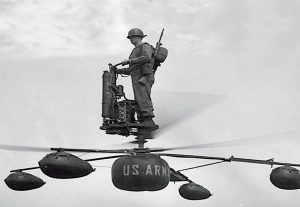
What could possibly go wrong?
Yes that’s right, the US Army developed a cross-between a ‘Segway’ and a helicopter, and no that image is not photoshopped. A decade after the creation of the helicopter during WWII, someone decided to try something a little bit different by creating a personal, one-man helicopter… without the cockpit, stability, or expensive armor-plating. As the Cold War was heating up, the 1950’s were a bit of a wild west in terms of weapons development. Generals on both sides were throwing everything at the wall to try and get some kind of edge over their adversary.
“The Aerocycle” (or the De Lackner HZ-1 Flying Platform) was the latest in a long line of bad ideas. First introduced in 1954, the HZ-1 was intended to be operated by any random soldier with just 20 minutes of training. At this point in history, most military officials just kind of assumed that the nuclear war was going to be the next hip thing, so these babies were designed to help soldiers traverse the barren, scorched, radioactive remains of what used to be a battlefield. Those dreams were dashed however when it turned out that untrained infantrymen kept crashing these flying deathtraps. The project was promptly cancelled (and brushed under the rug) that same year.

11. “The Salmon” Lockheed XFV-1 (1954-1955)
If the ‘Flying Pancake’, ‘The Goblin’ and ‘The Aerocycle’ weren’t bad enough, wait till you get a load of “The Salmon”!

Lockheed introduced the XFV-1 in 1954. This was an early attempt at a VTOL (vertical takeoff and landing) aircraft for the US Navy. While it may have been a clever concept in theory, in practicality, the Salmon (sometimes referred to as “the pogo-stick”) was a godawful design when it came to actually being able to hold its own in combat. The XFV-1 was notoriously hard to fly and was only ever flown by test pilot Herman “Fish” Salmon, hence the nickname.
Even though it was specifically designed for vertical take off, it only did so once… and it was by accident! The rest of the 32 test flights from Edwards Airforce Base were strictly with horizontal takeoffs and landings. Only two prototypes were built and only one ever flew, with the whole project being shelved unceremoniously a year later, due to poor performance.
12. GA-33: Goodyear’s “Inflatoplane” (1955-1962)
In 1955, someone at the Goodyear corporation thought an *inflatable plane* would be a good idea…

Spoilers: It wasn’t…
I’m still not entirely sure how someone signed off on this one, but the GA-33 aka the Goodyear “Inflatoplane” was supposed to be a “compact” last minute solution for airmen who were trapped behind enemy lines. As you can imagine, even if said personnel managed to inflate the ‘blow-up’ airplane, they would still need to find a useable runway, and even if they managed to take off, the dubious craft’s max speed was a mere 55-mph, meaning they’d be an even easier and far more vulnerable target flying through enemy airspace, that would presumably be on high alert after already shooting down said pilots the first time.
This is also probably why the CIA opted instead for cyanide pills for their U-2 Spy Planes.
13. SNECMA Coléoptère (1958-1959)
Another (failed) attempt at a VTOL aircraft was France’s SNECMA C.450 “Coléoptère” – which apparently means “beetle” in French.
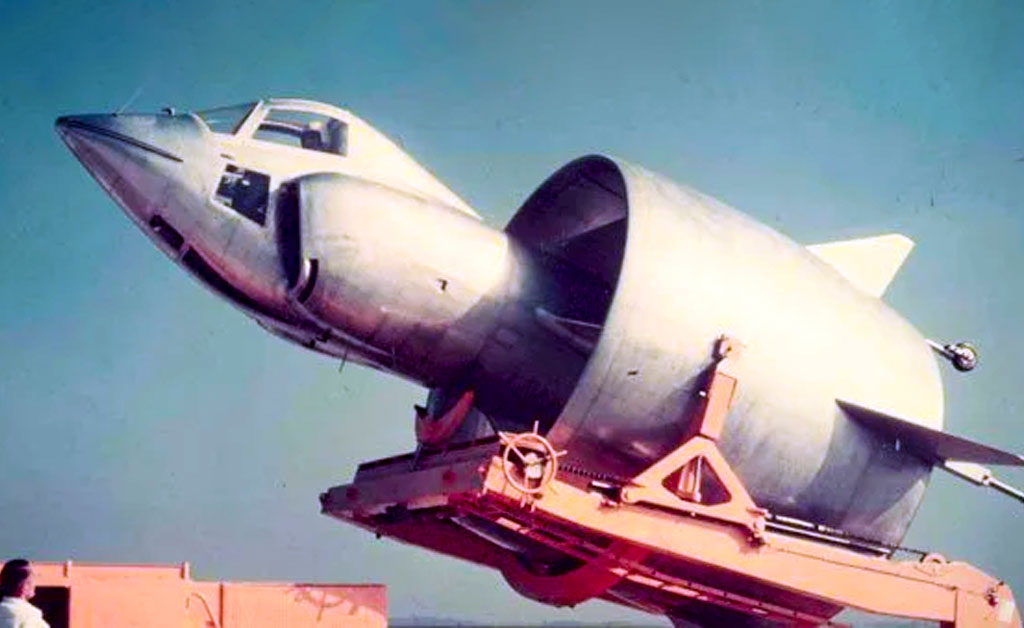
This bulky, rocket-shaped, single-pilot craft looks like a fighter jet being sucked into a bigger jet engine! Designed strictly for vertical-take-off-and-landing, and powered by a single axial-flow turbojet, the Coléoptère featured an ejector seat that could tilt to match the flight mode of the aircraft, not unlike Boba Fett’s ship from Star Wars. The sole prototype made it’s maiden voyage in December of 1958. It was then destroyed during it’s ninth flight on July 25th, 1959, due to it’s cumbersome controls, limited visibility, and poor maneuverability. Thankfully the lone pilot was able to eject in the nick of time!
14. Curtiss-Wright VZ-7 “The Flying Jeep” (1958-1960)
Similar to ‘the Aerocycle’ (see above), “The Flying Jeep” honestly just looks like a low-budget helicopter, but hey, at least you can sit down in this one…
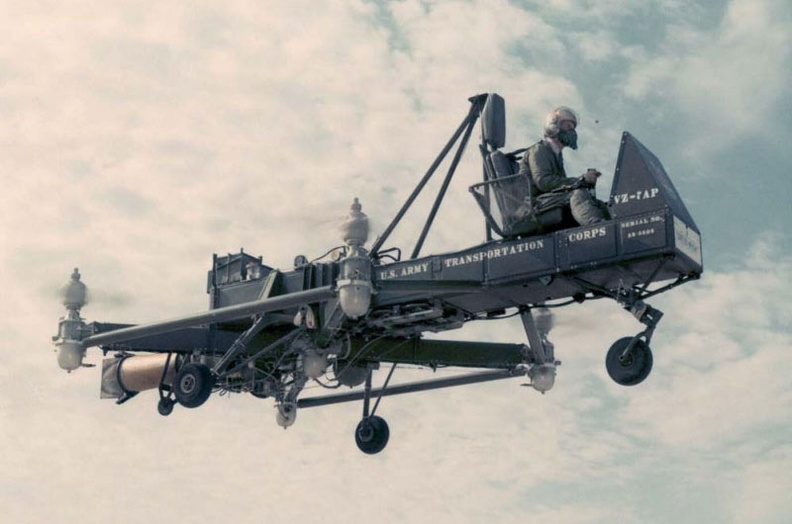
2 prototypes of “The Flying Jeep” were developed by the Curtis-Wright company in 1958. The VZ-7 was a compact, one pilot, quad-copter with a max speed of 32 miles-per-hour, and could only achieve an altitude of 200 feet. Similar to the other attempts at a ‘Flying Jeep’: the Chrysler VZ-6 and the Model 59K Skycar, the Army wasn’t too impressed and decided to pass. It may or may not have had something turning GI’s into slow, low-flying, exposed moving targets…
15. Avro Canada VZ-9 “Avrocar” (1958-1961)
Again, the 50’s were wild…
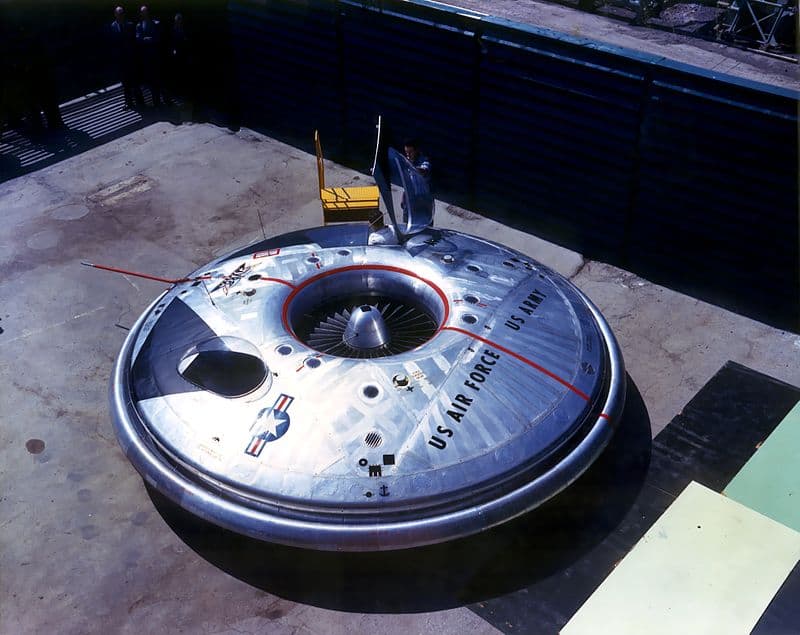
Just like the SR-71 Blackbird and B-2 Stealth Bomber, the VZ-9 “Avrocar” was also flown at “Area 51” – the Top-Secret Air Force base, near Groom Lake, just north of Las Vegas, Nevada – and, just like those later projects, was often mistaken as a UFO by civilians, because… obviously.
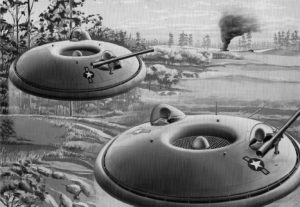
Originally developed by the Canadian company, Avro Canada, they then offered the project to the US Air Force. Initial evaluations were made at Wright-Patterson Airbase in Ohio, while wind-tunnel tests were conducted by NASA.
Designed as an experimental VTOL aircraft, in practicality it was really more of a rudimentary hovercraft… with incredibly poor handling. Using the Coandă effect, the idea was to use a single “turborotor” to generate both lift and thrust, but in test flights, the disc-shaped craft proved wildly unstable.
After years of poor performance, the “Avrocar” project was canceled for good in 1961, but it wouldn’t be the last “Flying Saucer” produced by the US government…
16. USAF – LRV: Lenticular Re-Entry Vehicle aka “The Flying Saucer” (1950’s-1960’s)
Yup, that’s right, the US government decided to double down on the whole “Flying Saucer” idea throughout the 1950’s and 60’s, right at the height of the UFO craze!
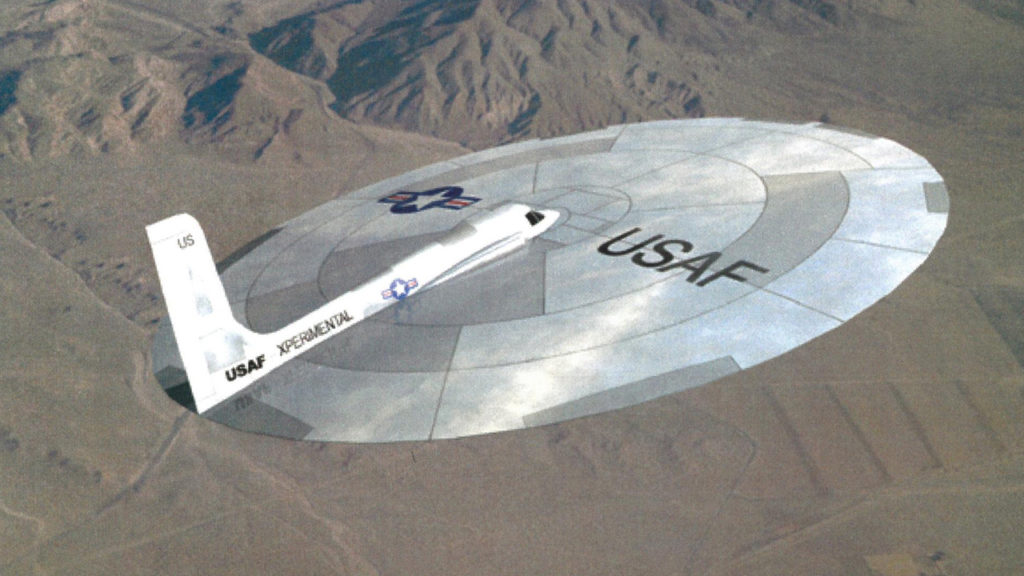
While the government officials at “Project Blue Book” were *ordered* to explain away mysterious anomalous sightings as mere “swamp gas” (true story) in an apparent attempt to keep the public from panicking (?), the US Air Force was further adding to the confusion by designing a top-secret experimental aircraft – that just so happened to look like the shinny metal saucers that people all around the world started seeing in the skies, during the late 1940’s! Which in turn, went on to inspire a whole lot of 50’s Sci-Fi B-Movies like “The Day the Earth Stood Still” (1951) and “Forbidden Planet” (1958)!

The LRV (Lenticular Re-Entry Vehicle) was “an experimental nuclear warhead delivery system under development during the Cold War by defense contractor North American Aviation, managed out of Wright-Patterson Air Force Base” – according to an issue of Popular Mechanics, shortly after the project was partially declassified in 1999.
Some have argued that the LRV’s “Flying Saucer” design was chosen to further explain away the literally *thousands* of unexplained sightings that were popping up around the US at the time, while others have proposed that the UFO sightings themselves may have been the inspiration for this rather unusual prototype. Maybe they just thought it looked cool? Regardless of the reason, this was a very real aircraft that was actually designed, constructed, and flown.
According to a report obtained from a Freedom of Information Act request, the LRV was “a 40-foot half-saucer with a flat rear edge”. It was apparently intended to “support a crew of four men for six-week orbital missions”, with propulsion from a rocket engine, that may or may not have contained an onboard nuclear reactor! Unfortunately, not much else is currently known about this extremely strange vehicle…
For more on the whole UFO subject, check out my article on 8 Mysterious UFO / UAP Encounters from History (218 BCE – 1945), and Episode 34 of the Epik Fails of History podcast, where I talked about the Roswell Incident of 1947!
17. The Soviet “Caspian Sea Monster” Korabl Maket (1964-1980)
Meanwhile, in Soviet Russia…

More boat than plane, the Russian “Caspian Sea Monster” is one of the largest (and heaviest) aircraft ever constructed! Developed by the USSR’s Central Hydrofoil Design Bureau in 1964, for the Soviet Navy, the Korabl Maket was a gigantic piece of engineering, with an absurd maximum takeoff weight of 544 metric tons! The KM was an early Ground-Effect-Vehicle (GEV), referred to as an “ekranoplan” in Russia.

It’s similar to a cross between a hovercraft and a seaplane – it’s much faster than a hovercraft (top speed: 310 mph or 270 knots), but basically can only hover over bodies of water, with a maximum altitude of just 45 feet. This behemoth of a vessel became the subject of intense American espionage throughout the Cold War, when satellite photos were taken, leading US intelligence to wonder what it was for and what it’s capabilities were.
The KM was unceremoniously destroyed when it crashed into the Caspian Sea, due to pilot error. Although the crew managed to evacuate, the insanely heavy hunk of metal slowly sank to the bottom of the sea, never to be recovered…
18. Russian Mil V-12 “Homer” (1968-1974)
Around the same time, the Soviets were also messing around with their own VTOL experiments…
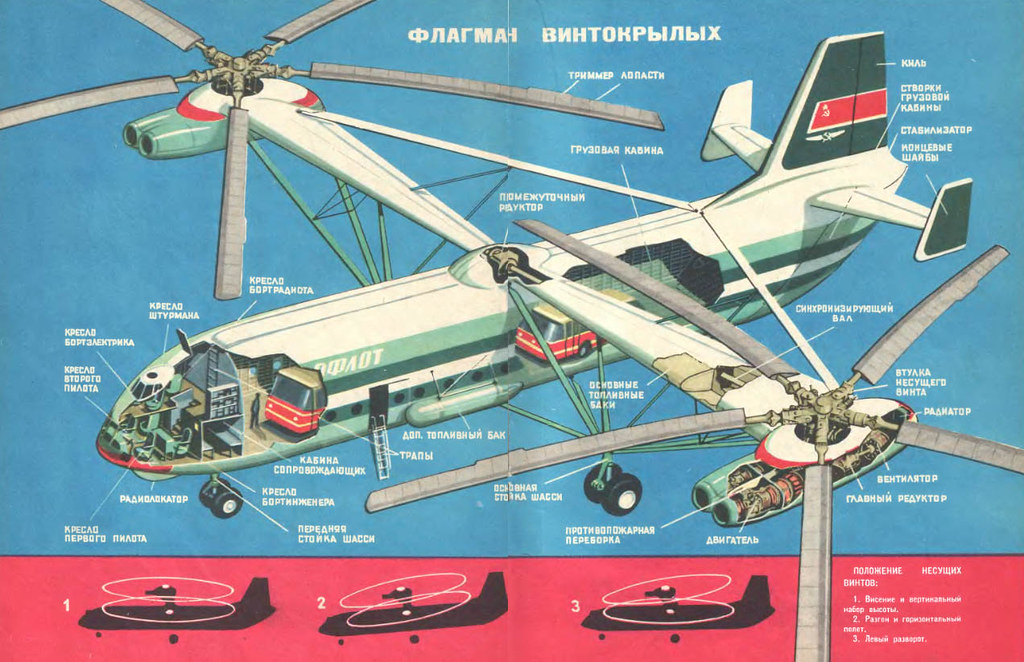
In 1960’s, the Soviet Union poured considerable resources into developing what would be the world’s largest helicopter ever constructed: the Russian Mil V-12! The V-12 (aka “Homer”) was shaped like a jumbo-jet, but with twin helicopter rotors at the ends of it’s 100-foot wingspan, and was capable of lifting 28 tons! This lumbering goliath had a max speed of 160 mph, with 4 turboshaft engines, giving it a whopping 26,000 horsepower! Although it went on to win awards and break a whole bunch of world records (with altitudes and payloads), ultimately Homer was plagued by numerous technical limitations.
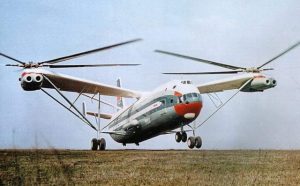
In fact, the V-12’s first test flight in June of 1967 failed spectacularly – harmonic amplification vibrations caused oscillations, which lead to the bulky chopper landing hard with a thud, bursting tires and damaging it’s landing gear! It’s first *successful* test flight didn’t occur until July, 1968. The project was eventually shuttered in 1974, after the Russian government realized that the whole point of the project: a strategic bomber built to deploy heavy ballistic missiles was no longer needed.
Around the same time, the Russians also developed the amphibious Bartini Beriev VVA-14 also originally intended as a VTOL aircraft, but it too failed to deliver on that promise.
19. Dornier “Aerodyne” (1972)
In 1972, the government of West Germany also decided to take a crack at the whole VTOL thing…

The result was one of the strangest and most pointless aircraft ever built: the Dornier “Aerodyne” – a *wingless*, unmanned, remote-controlled craft – just to prove that it could be done. It was basically an early drone prototype. The Aerodyne’s first flight on September 18th, 1972 was a relative success. The German Armed Forces however pulled the plug just two months later on November 30th, 1972, due to a “lack of interest”.
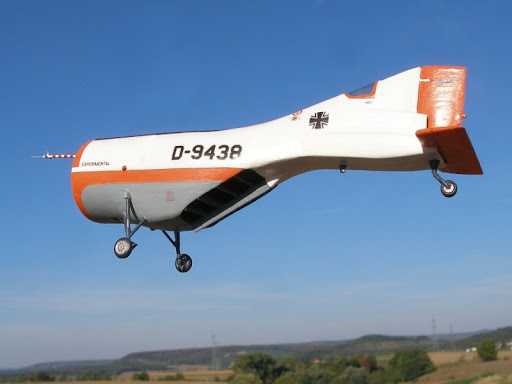
20. Rockwell XFV-12 (1977-1981)
In 1977, the military contractors for the US Navy once again attempted to crack the ever elusive VTOL problem. This time, with a fancy new prototype: the Rockwell XFV-12 – a Mach 2.2, Super-Sonic Jet!
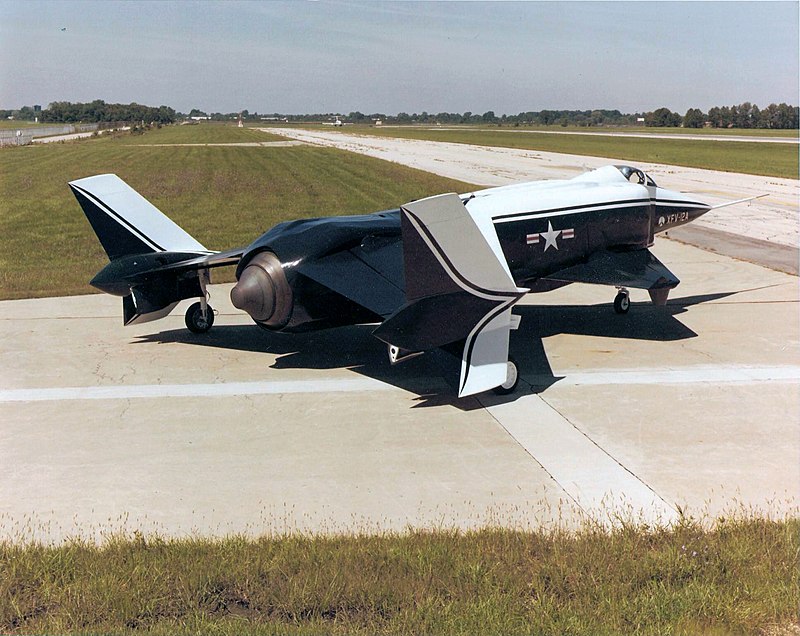
Despite the badass look, with a cutting-edge “thrust augmentor wing” (whatever that is), and costing tax payers roughly $3.26 billion, during pre-flight testing, the scientists at NASA determined that the XFV-12 had “suffered from major deficiencies” and was “incapable of flight”! The system’s thrust was 30% less than expected and it’s engines were only capable of lifting about three-quarters of the aircraft. The whole ridiculously expensive program was terminated in 1981, without a single test flight to show for it…
Honorable Mention: The Sikorsky X-Wing (1976-1988)

Seriously, this one looks like a kid designed it! WTF?
For more aviation-related history, be sure to check out 15 Early *Failed* Attempts at Flight, and 25 Epic Aviation Milestones, as well as the Epik Fails of History podcast, and my ‘Epic Fails’ books: “The Wright Brothers: Nose-Diving Into History” and “The Race to Space: Countdown to Liftoff”!
– Erik Slader
Sources:

https://en.wikipedia.org/wiki/Christmas_Bullet
https://en.wikipedia.org/wiki/Caproni_Ca.60#Test_flights
https://en.wikipedia.org/wiki/Bl%C3%A9riot_125
https://en.wikipedia.org/wiki/Kalinin_K-7
https://en.wikipedia.org/wiki/Stipa-Caproni
https://en.wikipedia.org/wiki/Nemeth_Parasol
https://disciplesofflight.com/nemeth-parasol-strange-aircraft/
https://en.wikipedia.org/wiki/Blohm_%26_Voss_BV_141
https://en.wikipedia.org/wiki/Vought_V-173
https://en.wikipedia.org/wiki/McDonnell_XF-85_Goblin#Specifications
https://en.wikipedia.org/wiki/De_Lackner_HZ-1_Aerocycle
https://en.wikipedia.org/wiki/Lockheed_XFV
https://en.wikipedia.org/wiki/SNECMA_Col%C3%A9opt%C3%A8re
https://en.wikipedia.org/wiki/Curtiss-Wright_VZ-7
https://en.wikipedia.org/wiki/Mil_V-12#Operational_history
https://en.wikipedia.org/wiki/Dornier_Aerodyne
https://en.wikipedia.org/wiki/Rockwell_XFV-12
https://www.pilotmall.com/blogs/news/20-of-the-weirdest-planes-ever-to-take-flight
https://www.nationalmuseum.af.mil/Visit/Museum-Exhibits/Fact-Sheets/Display/Article/195801/avro-canada-vz-9av-avrocar/




